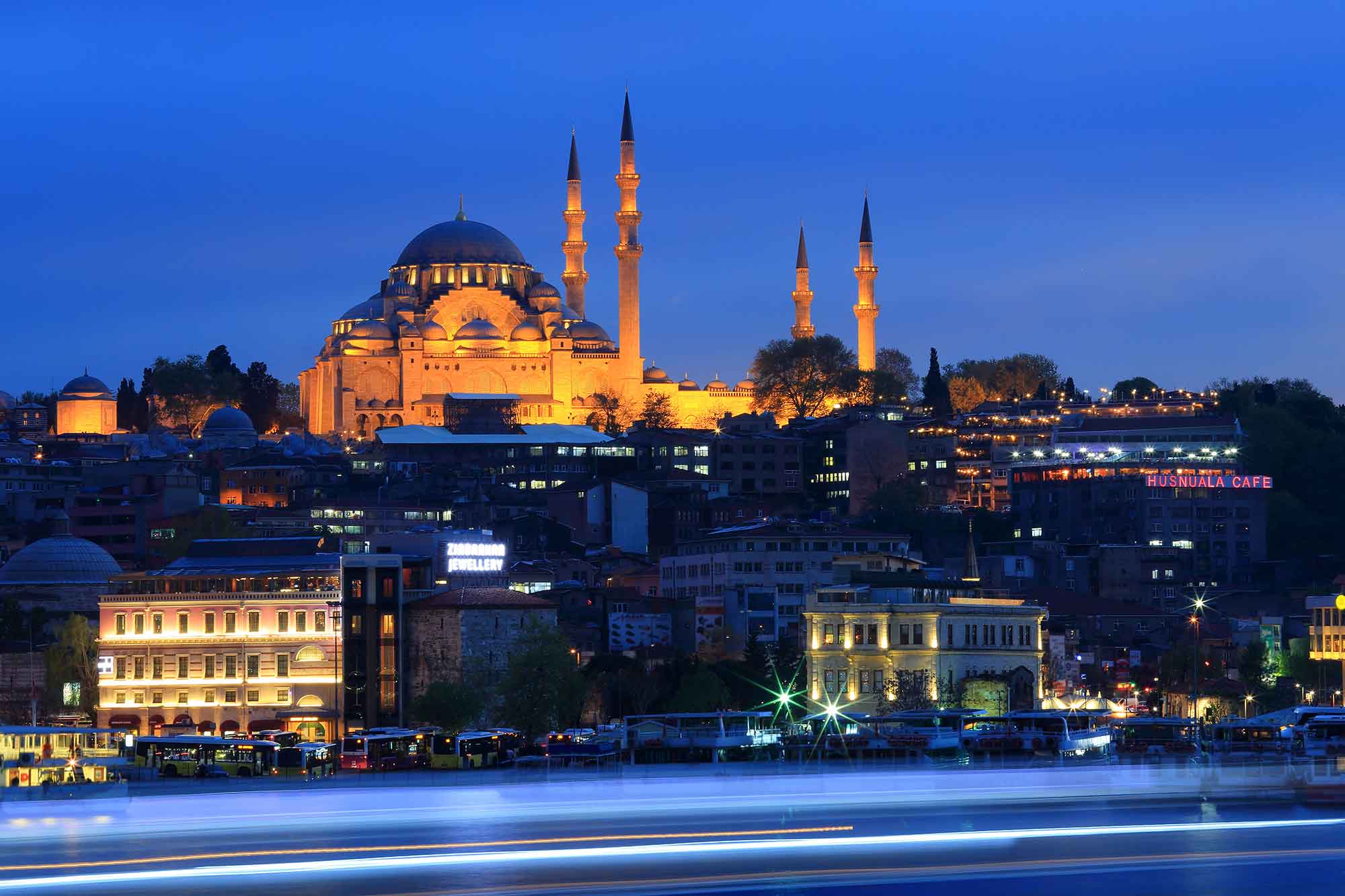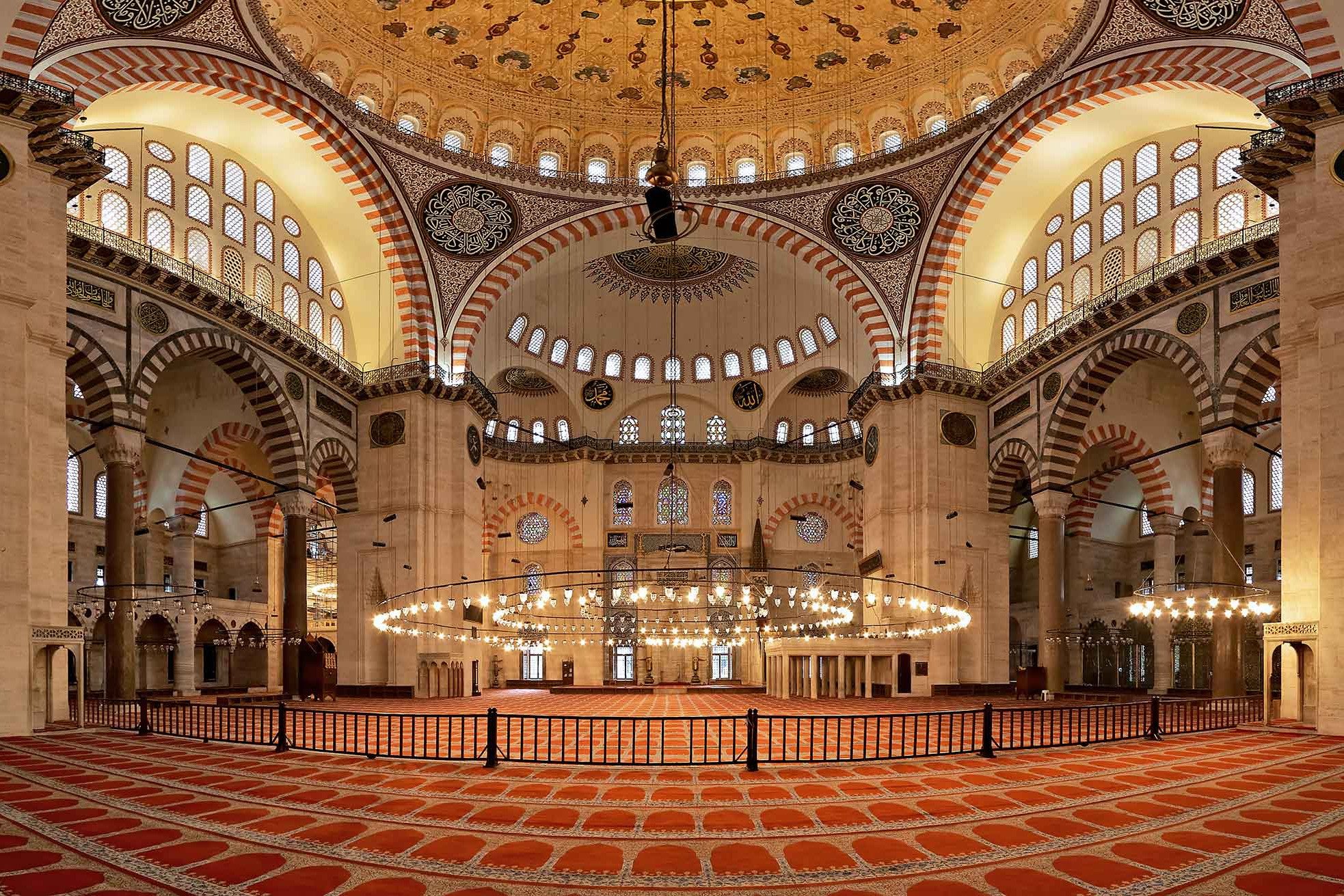Suleymaniye Mosque
When Was Suleymaniye Mosque Built?
The Süleymaniye Mosque was built between 1551 and 1558 by order of the Ottoman Sultan Suleyman the Magnificent. Suleymaniye Mosque is one of the most prominent examples of Classical Ottoman Architecture. There are four minarets which are 75 meters high, two of which have three and the other two with two balconies each. The dome of the mosque has a height of 53 meters. The mosque is on the third hill of Istanbul, which is one of the most beautiful places in Istanbul.
The Architecture of Suleymaniye Mosque
The mosque has a central dome, two half domes, and two-quarter domes and ten smaller domes. The central dome has four elephant legs; dome arches retain four large granite columns. The 32-window dome is 27.25 meters in diameter and 53 meters above the ground. There are 64 cubes of 50 cm in length, placed inside the dome and in the corners of the building, with the mouth open inside, creating sensitive acoustics. The Suleymaniye Mosque has an interior area of approximately 3,500 square meters, is 59 meters long and 58 meters wide, and receives light through 238 windows. The sultan and muezzin loge, which are on granite and marble columns and the craftsmanship of the minbar and mihrab, draw every visitor’s attention. The section, which is surrounded by metal networks to the right of the muezzin mahfil, was used as a library until 1918. The existing books were transferred to the Public Library at the Suleymaniye Madrasahs on the same date.
The mosque, which has five doors, has colored windows on the front of the mihrab. The windows are the work of the well-known master of the period, İbrahim Usta, in which Architect Sinan compares the sunlight coming through its windows to the wings of Angel Gabriel. There are four very precious granite columns in the Suleymaniye Mosque. They were taken from different parts of Istanbul, Alexandria, Baalbek, and brought to the mosque. These four columns, each with a height of 9.02 meters and a diameter of 1.14 meters and 40-50 tons, resemble Mimar Sinan to the Four Caliphs. The floor of the mosque has a large inner courtyard with three doors surrounded by marbles and surrounded by porches with 28 domes. Dome arches are on 24 columns.12 of them are granite, 10 are marble, and 2 are porphyry marble columns.


Minarets of Suleymaniye
The mosque has four minarets and ten balconies built per its majesty. Two of the minarets have three, and the other two have two balconies each. The minarets called “Mosque Minarets” and “Harem Minarets” symbolizes Suleyman the Magnificient as the fourth sultan after the conquest of Istanbul; Ten balconies indicates that he was the tenth sultan of the Ottoman Empire. The minarets rising towards the sky are like a praying person with both hands raised.
Caligraphy Art of the Mosque
The writings in the mosque are the work of the famous calligrapher Ahmet Karahisari and his student Hasan Celebi. Later, Kazasker Mustafa Efendi added some articles. Except for a few of the writings, the text of all of them is from the Quran, and the artists created them skillfully.
The inscription, written on the door, entered into the Suleymaniye Mosque from the inner courtyard is divided into three sections as right-middle-left. In the first part, there are the qualifications of the Law. The second part has the genealogy (lineage) indicated in sequence. In the third part, after the prayer to the continuation of the reign and the souls of the past, it states with what purpose and when they made superior qualities of the mosque. The tomb in front of the altar belongs to Suleyman the Magnificent, who built a mosque with his own money. The tomb next to him belonged to his wife Roxellana, Hurrem Sultan.
Complex Buildings
The mosque garden, which has an area of approximately 6 thousand square meters, has 11 doors. Seven Madrasa (schools) are surrounding the garden. Five of which are famous as Suleymaniye Madrasas, at the high school level, one of which is a faculty, and the other is a specialized department. While the buildings on the right side of the mosque were schools as well, they were later notified (changed) to the Suleymaniye Library, and some of them became a children’s library.
The medical madrasah (school) on the corner serves as a delivery house, while the building opposite it serves as a girl’s Qur’an course. While the buildings on the northern side of the mosque were first imaret houses, they were later used as the museum of Turkish-Islamic Works and transferred to the Suleymaniye Library in 1984.
Private Tours of Suleymaniye Mosque
If you are interested in visiting the Suleymaniye Mosque with an experienced private tour guide, please contact us! Our private tours are the best option to enjoy wonderful and complex sites such as the Suleymaniye Mosque.
Let us make your time in Istanbul a memorable one!